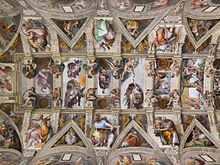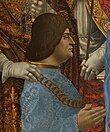This is an old revision of this page, as edited by Mandsford (talk | contribs) at 02:42, 16 April 2023 (→October–December). The present address (URL) is a permanent link to this revision, which may differ significantly from the current revision.
Revision as of 02:42, 16 April 2023 by Mandsford (talk | contribs) (→October–December)(diff) ← Previous revision | Latest revision (diff) | Newer revision → (diff)
| This article needs additional citations for verification. Please help improve this article by adding citations to reliable sources. Unsourced material may be challenged and removed. Find sources: "1508" – news · newspapers · books · scholar · JSTOR (May 2021) (Learn how and when to remove this message) |
| Millennium: | 2nd millennium |
|---|---|
| Centuries: | |
| Decades: | |
| Years: |
| 1508 by topic |
|---|
| Arts and science |
| Leaders |
| Birth and death categories |
| Births – Deaths |
| Establishments and disestablishments categories |
| Establishments – Disestablishments |
| Works category |
| Gregorian calendar | 1508 MDVIII |
| Ab urbe condita | 2261 |
| Armenian calendar | 957 ԹՎ ՋԾԷ |
| Assyrian calendar | 6258 |
| Balinese saka calendar | 1429–1430 |
| Bengali calendar | 915 |
| Berber calendar | 2458 |
| English Regnal year | 23 Hen. 7 – 24 Hen. 7 |
| Buddhist calendar | 2052 |
| Burmese calendar | 870 |
| Byzantine calendar | 7016–7017 |
| Chinese calendar | 丁卯年 (Fire Rabbit) 4205 or 3998 — to — 戊辰年 (Earth Dragon) 4206 or 3999 |
| Coptic calendar | 1224–1225 |
| Discordian calendar | 2674 |
| Ethiopian calendar | 1500–1501 |
| Hebrew calendar | 5268–5269 |
| Hindu calendars | |
| - Vikram Samvat | 1564–1565 |
| - Shaka Samvat | 1429–1430 |
| - Kali Yuga | 4608–4609 |
| Holocene calendar | 11508 |
| Igbo calendar | 508–509 |
| Iranian calendar | 886–887 |
| Islamic calendar | 913–914 |
| Japanese calendar | Eishō 5 (永正5年) |
| Javanese calendar | 1425–1426 |
| Julian calendar | 1508 MDVIII |
| Korean calendar | 3841 |
| Minguo calendar | 404 before ROC 民前404年 |
| Nanakshahi calendar | 40 |
| Thai solar calendar | 2050–2051 |
| Tibetan calendar | 阴火兔年 (female Fire-Rabbit) 1634 or 1253 or 481 — to — 阳土龙年 (male Earth-Dragon) 1635 or 1254 or 482 |

Year 1508 (MDVIII) was a leap year starting on Saturday (link will display the full calendar) of the Julian calendar.
Events
January–March
- January 24 – Maximilian, King of the Romans, requests permission to march to Rome through Venetian territory, but is denied and begins his Italienzug.
- February 2 – During the Glinski rebellion, Lithuanian noble Mykolas Glinskis attacks Grodno (now in Belarus) and decapitates Jan Zabrzeziński, the top ally of Grand Duke Alexander.
- February 4 – Maximilian, King of the Romans, proclaims himself Holy Roman Emperor at the Italian city of Trento, after having been blocked by Venice from traveling to Rome to be crowned by Pope Julius II.
- February 20 – Maximilian I, Holy Roman Emperor, attacks the Republic of Venice and sack Ampezzo the next day.
- February 28 – Louis V becomes the new prince elector of the Palatinate upon the death of his father, Philip.
- March 2 – The Republic of Venice defeats Maximilian I in the Battle of Cadore.
- March 5 – La Cassaria by Ludovico Ariosto, the first Italian language comedy, is premiered at Ferrara.
- March 6 – Zahīr ud-Dīn Muhammad, Amir of Kabul, takes on the imperial title of Padishah.
- March 13 – The oldest annual foot race in Europe, the "Red Hose Race", is run for the first time, taking place in Scotland at Carnwath, Lanarkshire.
- March 18 – Wilhelm IV becomes the new Duke of Bavaria upon the death of his father, Albrecht IV.
- March 22 –
- Working from the house of Piero di Braccio Martelli at Florence, Leonardo da Vinci begins writing his "collection without order" of his scientific discoveries.
- Ferdinand II of Aragon appoints Florentine merchant Amerigo Vespucci to the post of Chief Navigator of Spain.
April–June
- April 23 – Prince Mihnea cel Rău, son of Vlad the Impaler, becomes the Voivode of Wallachia, with a palace at Târgoviște (now in Romania), upon the death of his cousin Radu IV the Great.
- April 26 – Hatuey, leader of the indigenous people of Hispaniola as Cacique of the Taíno tribe in the fight against the invading Spaniards, is deposed. He will be executed in 1512.
- May 8 – Italian renaissance artist Michelangelo di Lodovico Buonarroti Simoni of Florence signs a contract with the Vatican to paint the Sistine Chapel ceiling, in return for a promised fee of 3,000 gold ducats (equivalent in 2023 to more than U.S. $600,000).
- June 4 – The coronation of Prince Lajos as the designated successor to his father, King Vladislaus II of Hungary, takes place in Székesfehérvár.
- June 6 – Holy Roman Emperor Maximilian I signs a humiliating armistice with the Republic of Venice, renouncing all Habsburg claims to territories in Italy.
July–September
- July 23 – Upon the death of his father, King Oxlahuh-Tz'i, Hun-Iqʼ becomes one of the two kings of Guatemala's Kaqchikel Maya civilization. Hun-Iqʼ reigns jointly with King Kablahuh-Tihax until the latter's death on February 4.
- July 27 – The process of removing the former layers of paint on the ceiling of the Sistine Chapel is completed, and Michelangelo begins the next phase of marking the surface for painting.
- July 31 – Prince Lebna Dengel, age 12, becomes the new Emperor of Ethiopia upon the death of his father, the Emperor Na'od, in Shewa. He takes the regnal name of Dawit II.
- August 12 — The Spanish settlement of Puerto Rico begins on the island of Borinquén by Juan Ponce de León. Upon his arrival, Ponce is welcomed by Agüeybaná I, the island's leader a Cacique of the Taíno people. The Spanish explorer gives the port the name San Juan Bautista upon arriving at Caparra, near what is now the town of Guaynabo.
October–December
- October 8 – An inconclusive peace treaty is signed to end the third of the Muscovite–Lithuanian Wars.
- October 24 – King Louis XII of France convenes court at the Parlement de Normandie building in Rouen.
- November 1 – At the age of 16, Prince Wolfgang of the House of Ascania becomes the new ruler of the German principality of Anhalt-Köthen, succeeding his father Waldemar VI. In 1521, he will meet Martin Luther and, in 1525, will introduce the Reformation to his principality, making Anhalt-Köthen only the second nation (after the Electorate of Saxony) to officially adopt Protestantism.
- November 29 – Astronomer Mikołaj Kopernik of Poland is granted benefits and a waiver of canon law by Pope Julius II in order to perform his work.
- December 10 – The League of Cambrai is formed as an alliance against the Republic of Venice, between Pope Julius II, Louis XII of France, Maximilian I, Holy Roman Emperor and Ferdinand II of Aragon.
- December 29 – Battle of Dabul: Portuguese forces, under the command of Francisco de Almeida, attack Khambhat.
- December – Michelangelo begins painting the Sistine Chapel ceiling in the Holy See of Rome, on a commission by Pope Julius II (signed May 10).
Births

- February 17 – Bernardo Salviati, Italian Catholic cardinal (d. 1568)
- April 3 – Jean Daurat, French writer and scholar (d. 1588)
- April 5 – Ercole II d'Este, Duke of Ferrara, Italian noble (d. 1559)
- April 23 – Georg Sabinus, German writer (d. 1560)
- May 8 – Charles Wriothesley, English Officer of Arms (d. 1562)
- June 8 – Primož Trubar, Slovenian Protestant reformer who lays the foundations for the Slovenian written language (d. 1586)
- June 10 – Hedwig of Münsterberg-Oels, German noble (d. 1531)
- June 13 – Alessandro Piccolomini, Italian humanist and philosopher from Siena (d. 1579)
- June 29 – Balthasar of Hanau-Münzenberg, German nobleman (d. 1534)
- September 19 – Maria Paleologa, Italian noblewoman (d. 1530)
- September 23 – Simon Sulzer, Swiss theologian (d. 1585)
- September 25 – Francisco Mendoza de Bobadilla, Spanish Catholic cardinal (d. 1566)
- November 23 – Francis, Duke of Brunswick-Lüneburg, youngest son of Henry the Middle (d. 1549)
- November 25 – Cristofano Gherardi, Italian painter (d. 1556)
- November 30 – Andrea Palladio, Italian architect (d. 1580)
- December 9 – Gemma Frisius, Dutch mathematician and cartographer (d. 1555)
- December 21 – Thomas Naogeorgus, German playwright (d. 1563)
- December 24 – Pietro Carnesecchi, Italian humanist (d. 1567)
- date unknown
- Livio Agresti, Italian painter (d. 1580)
- Matsunaga Hisahide, Japanese daimyo (d. 1577)
- Marin Držić, Croatian playwright (d. 1567)
- possible
- Isabel de Josa, Catalan writer (d. 1575)
- Jane Seymour, third queen of Henry VIII of England (d. 1537)
Deaths

- February – Robert Lauder of the Bass, governor of Berwick-on-Tweed (b. c. 1440)
- February 4 – Conrad Celtes, German humanist (b. 1459)
- February 15 – Giovanni II Bentivoglio, tyrant of Bologna (b. 1443)
- February 27 – James, Duke of Rothesay, heir to the throne of Scotland (b. 1507)
- February 28 – Philip, Elector Palatine (b. 1448)
- March 18 – Albert IV, Duke of Bavaria (b. 1447)
- March – Lourenço de Almeida, Portuguese explorer
- April 10 – Guidobaldo da Montefeltro, Italian condottiero (b. 1472)
- May 21 – Giles Daubeney, 1st Baron Daubeney (b. 1451)
- May 27 – Ludovico Sforza, Duke of Milan (b. 1452)
- June 6 – Ercole Strozzi, Italian poet (b. 1473)
- June 15 – Bernard Stewart, 4th Lord of Aubigny (b. c. 1452)
- July 28 – Robert Blackadder, Bishop of Glasgow
- July 31 – Na'od, Emperor of Ethiopia (in battle)
- September 23 – Beatrice of Naples, queen consort of Hungary (b. 1457)
- October 18 – Patrick Hepburn, 1st Earl of Bothwell, Lord High Admiral of Scotland
- October 10 – János Thurzó, Hungarian businessman (b. 1437)
- October 23 – Edmund de Ros, 10th Baron de Ros, English politician (b. 1446)
- November 25 – Ursula of Brandenburg, Duchess of Münsterberg-Oels and Countess of Glatz (b. 1450)
- December 10 – René II, Duke of Lorraine (b. 1451)
- December 16 – Henry the Younger of Stolberg, Stadtholder of Friesland (1506–1508) (b. 1467)
- December 22 – Eric II, Duke of Mecklenburg (b. 1483)
- date unknown
- Isaac Abravanel, Portuguese statesman, philosopher and theologian (b. 1437)
- Mahmud Khan (Moghul Khan), Khan of Tashkent
- Micheletto Corella, Valencian condottieri
- Damkhat Reachea, emperor of Cambodia
- Ahmad al-Wansharisi, North African Islamic jurist and theologian
References
- Mead Skjelver, Daniel. "Maximilian I Holy Roman emperor". Encyclopedias Britannica. Encyclopedias Britannica. Retrieved May 5, 2021.
- Yvonne Paris, Michelangelo: 1475–1564 (Parragon, 2009)
- Linda Schele and Peter Mathews, The Code of Kings: The Language of Seven Maya Temples and Tombs (Simon & Schuster, 1999) p.297
- Rimvydas Petrauskas and Jūratė Kiaupienė, Lietuvos istorija. Nauji horizontai: dinastija, visoumenė, valstybė (The History of Lithuania, New Horizons: Dynasty, Unification, State) (Baltos Lankos, 2009), p. 466
- John Duncan Mackie (December 31, 1952). The Earlier Tudors, 1485-1558. Clarendon Press. p. 155. ISBN 978-0-19-821706-0.
- "Battle of Dabul - [December 29, 1508] This Day in History". Byjus. Retrieved May 5, 2021.
- Leo Steinberg (December 31, 2019). Michelangelo's Painting: Selected Essays. University of Chicago Press. p. 3368. ISBN 978-0-226-48243-9.
- Virginia Trimble; Thomas R. Williams; Katherine Bracher (September 18, 2007). Biographical Encyclopedia of Astronomers. Springer Science & Business Media. p. 904. ISBN 978-0-387-30400-7.
- Georgian Group (London, England) (1957). Visit to the Veneto 21st-29th September, 1957: Programme. p. 1.